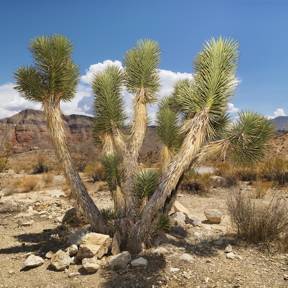Gene Deserts Take the Life out of Evolution’s Best Argument
I always imagined the desert as a lifeless sea of sand and heat—at least until about eight years ago. In early February I drove across the Mojave Desert on my way to Las Vegas. To my surprise, the desert landscape was vibrant with life at that time of the year.

There are also deserts in the human genome. These regions, known as gene deserts, are devoid of genes. Because of the vastness of these regions, most life scientists did not think gene deserts served any type of functional importance. But this view is changing rapidly.
Like my drive through the desert, researchers are surprised to discover that gene deserts are anything but devoid of functional importance. For example, a team recently discovered that a particularly large gene desert on human chromosome 9 is actually a vibrant area of the genome, teeming with genetic activity.1
These types of discoveries have biomedical importance and may shed light on diseases like Type 2 diabetes and coronary artery disease. They also have implications for the creation-evolution controversy.
Gene Deserts and the Case for Biological Evolution
Loosely speaking, a gene is a region of DNA that harbors instructions used by the cell’s machinery to make a single protein. Yet only a small fraction of the human genome (around five percent or less) consists of protein-coding sequences. Most of the genome consists of noncoding DNA. Many biologists assume that a large fraction of this noncoding DNA is junk—functionless sequences interpreted as evolutionary vestiges.
Gene deserts epitomize this view of noncoding DNA. For evolutionary biologists, it’s tempting to look at these DNA regions as a genetic wasteland, prompting the question, Why would an all-powerful, all-knowing Creator produce genomes with such large regions of functionless DNA?
Life in the Gene Desert
A few years ago, biomedical investigators discovered that certain genetic variations in the gene desert of human chromosome 9 were associated separately with Type 2 diabetes and with coronary artery disease. This work clearly indicated that while the gene desert of chromosome 9 was devoid of genes, it didn’t lack function. But biologists didn’t know the functional basis for this association.
New work by scientists from University of California, San Diego, revealed that the gene desert of chromosome 9 is rich in DNA sequence elements called enhancers, which play a role in regulating gene expression. Apparently, certain genetic variants in this region disrupt the enhancers and alter gene expression patterns.
Given the prevailing view of gene deserts, this result was unexpected. According to Kelly A. Frazer, one of the study’s authors, “The association of this interval with CAD [coronary artery disease] was a surprise and not expected as it is a ‘gene desert’ and the flanking genes, which are far away, have little to do with lipid metabolism, one of the primary factors in heart disease.”
Researchers are uncovering more and more examples of the functional importance of junk DNA. In light of this ongoing advance, it is becoming harder and harder to maintain that genomes are riddled with useless evolutionary vestiges. Instead, it is becoming increasingly apparent that genomes are elegant, sophisticated systems, worthy of a Creator.
Endnotes
- Olivier Harismendy et al., “9p21 DNA Variants Associated with Coronary Artery Disease Impair Interferon-Ɣ Signalling Response,” Nature 470 (February 10, 2011): 264–68.






